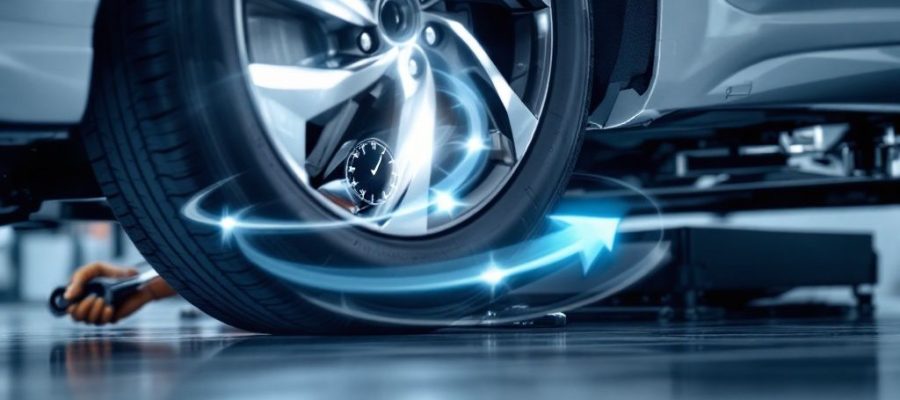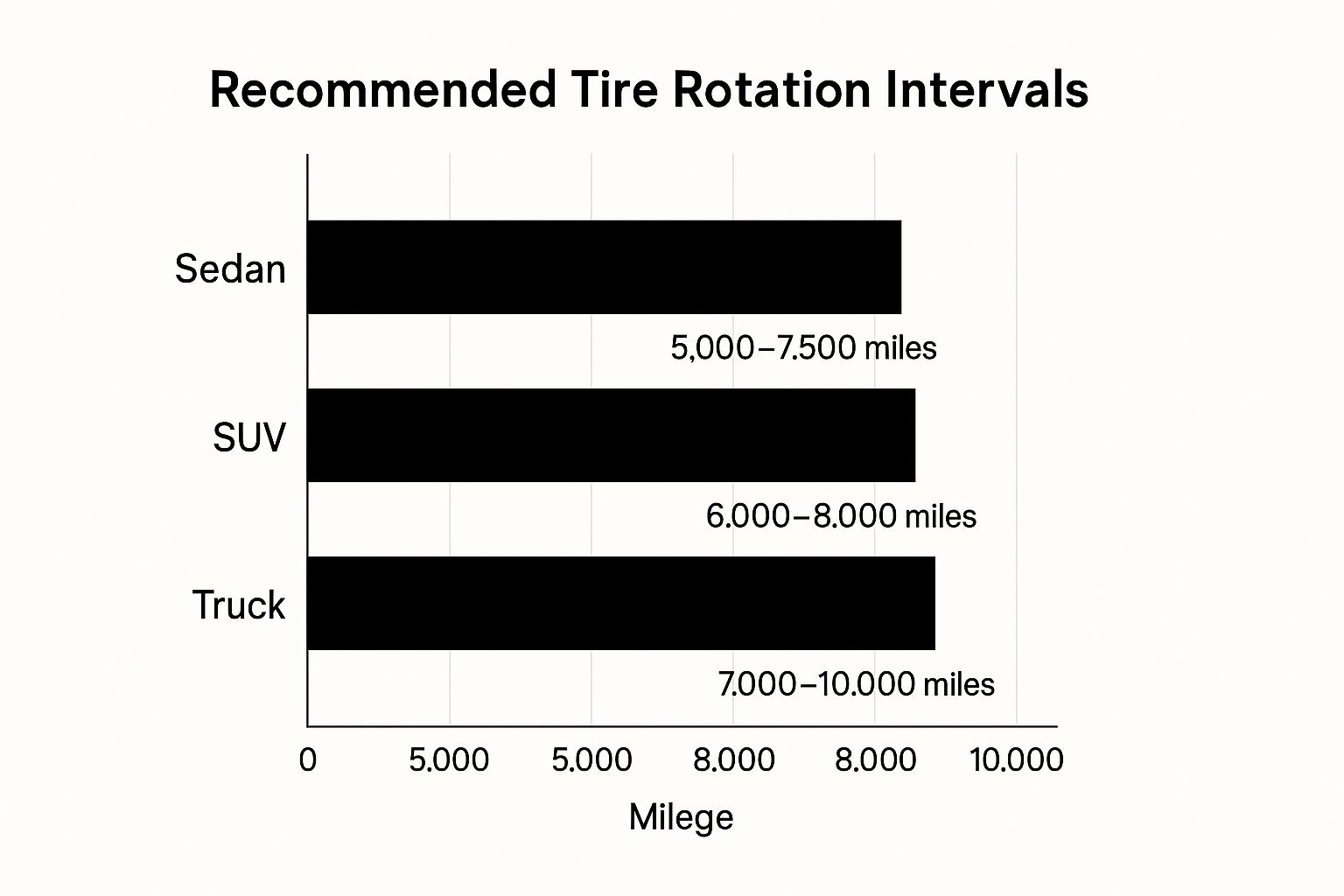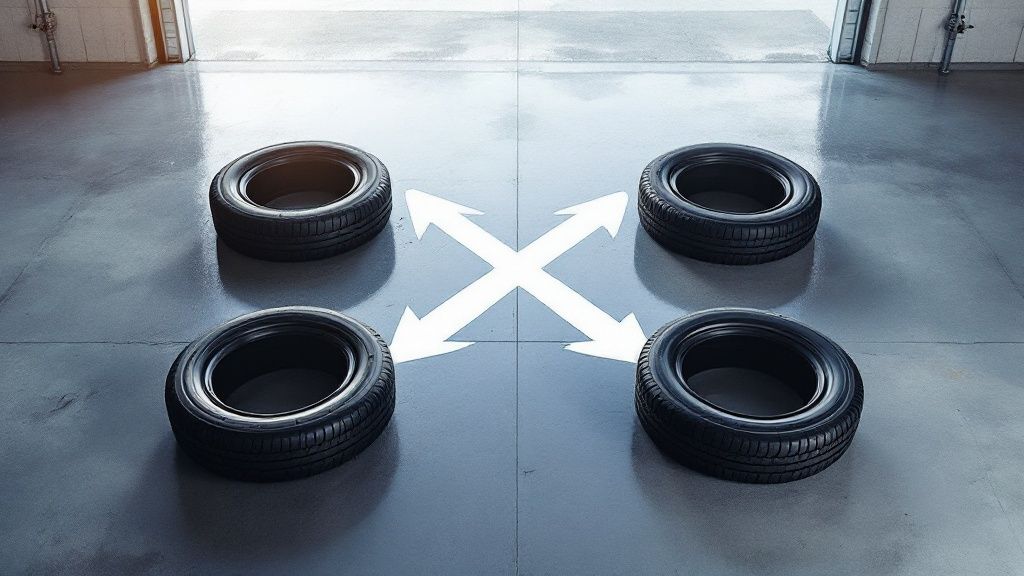

Tire rotation often gets overlooked as a simple maintenance task. However, understanding its impact reveals its true significance for both performance and safety. It's not just about moving tires around; it's about strategically managing their wear and tear. Different forces act on each tire depending on its position on the vehicle.
For example, front tires on front-wheel drive cars handle the majority of steering and braking forces, leading to increased wear compared to rear tires. This uneven wear can negatively impact handling and traction, particularly in adverse weather conditions like rain or snow.
Regular tire rotation helps counteract these wear patterns. By periodically changing the tires' positions, the wear is distributed more evenly, maximizing the life of each tire. This simple practice can increase tire life by up to 20%, resulting in significant long-term cost savings.
Rotating your tires regularly offers tangible benefits in safety, tire longevity, and fuel efficiency, contributing to a better overall driving experience. A common recommendation is to rotate tires every 5,000 miles or every six months, whichever comes first. This helps prevent uneven tread wear, a major factor in tire degradation.
For instance, if front tires wear down faster due to the front-wheel drive systems in many vehicles, rotating them can redistribute that wear and extend the overall life of the tire set. Studies and expert opinions show that irregular or delayed tire rotation can lead to uneven tread depths. This not only compromises traction and increases the risk of hydroplaning but also necessitates premature tire replacements. Regularly checking your tread depth can help identify uneven wear early. This proactive approach, combined with scheduled rotations, significantly improves vehicle safety. Well-maintained tires also improve fuel economy by minimizing rolling resistance. These maintenance recommendations are standard practice in major automotive markets like the United States, Europe, and Asia, helping drivers maintain optimal tire performance and safety. For more in-depth information and statistics, check out this helpful resource: Learn More About Tire Rotation
Beyond tire rotation, maintaining all vehicle components is essential for optimal performance. For a helpful guide on general maintenance, consider this Office Equipment Maintenance Checklist. Proper tire rotation contributes to improved fuel efficiency and significantly enhances handling during emergency maneuvers. This means consistent tire rotation isn't just about tire longevity, but also about enhancing your overall driving experience and safety, translating to cost savings and peace of mind.

The "5,000-mile rule" for tire rotations is a fundamental aspect of vehicle maintenance. It's a balance between cost-effectiveness and optimal tire care. This mileage helps prevent uneven wear while minimizing how often you need service.
Waiting longer than 5,000 miles can lead to accelerated uneven wear. This impacts both safety and the lifespan of your tires.
This 5,000-8,000 mile recommendation often aligns with standard oil change intervals. This makes it simple to incorporate rotations into your regular maintenance at Kwik Kar of Mesquite. Combining these services saves you time and ensures your vehicle receives consistent care. This proactive approach can extend tire life by 20-40%.
A common industry standard for tire rotation is every 5,000 to 8,000 miles (roughly 8,000 to 13,000 kilometers). This often aligns with routine oil changes, simplifying maintenance schedules. Rotating tires in this range promotes even tread wear, essential for safety, handling, and maximizing tire life. Manufacturers often endorse this interval for its balance of convenience and wear distribution. Learn More About Tire Rotation Intervals
The 5,000 to 8,000-mile interval is data-driven. Fleet managers, who oversee many vehicles, see longer tire life with this schedule. Their experience highlights the practical benefits, especially for vehicles in constant use. For example, a 6,000-mile rotation schedule is often recommended for passenger vehicles under normal driving conditions.
The 5,000 to 8,000-mile guideline is a starting point. Specific driving habits and road conditions may require adjustments. Driving on rough terrain or carrying heavy loads may necessitate more frequent rotations.
Conversely, gentler driving may allow for a slightly longer interval. Check your owner's manual or consult the experts at Kwik Kar of Mesquite. They can help you determine the right schedule for your vehicle and driving style. Regular tire rotation is a worthwhile investment. It improves vehicle safety, performance, and fuel economy.
To further clarify the standard recommendation for tire rotation, let's examine a comparison of suggested intervals from various sources.
The following table provides a concise comparison of recommended tire rotation intervals from different sources, highlighting the consensus around the 5,000-8,000 mile benchmark.
Standard Tire Rotation Intervals Comparison
| Source | Recommended Interval (Miles) | Recommended Interval (Months) | Notes |
|---|---|---|---|
| Owner's Manual (Most Vehicles) | 5,000 – 8,000 | 6 – 12 | Varies depending on vehicle make and model |
| Kwik Kar of Mesquite | 5,000 – 8,000 | 6 – 12 | Aligns with oil change intervals |
| Stokes Trainor | Every 5,000-7,500 | N/A | Recommends checking with manufacturer |
| General Automotive Guidelines | 6,000 – 8,000 | 6 – 12 | For normal driving conditions |
As you can see, while there might be slight variations, most sources recommend a tire rotation every 5,000 to 8,000 miles or every 6 to 12 months. This reinforces the importance of regular rotations for maintaining tire health and vehicle safety.
Not all vehicles have the same tire rotation needs. Factors like your vehicle's configuration, your driving style, and even your location can affect tire wear. This means a standard tire rotation schedule isn't always the best approach.
High-performance vehicles, with their powerful engines and precise handling, often need more frequent tire rotations than a typical sedan. This increased stress on the tires leads to faster wear. Similarly, the instant torque of Electric Vehicles (EVs) creates distinct wear patterns.
SUVs and trucks, frequently carrying heavier loads and traversing rougher terrain, also have different rotation needs compared to lighter vehicles. Recognizing these differences is essential for maximizing tire life and ensuring optimal performance.
The infographic below shows recommended tire rotation intervals for various vehicle types.

As illustrated, trucks typically require more frequent rotations than sedans, with SUVs falling somewhere in between. This highlights how vehicle weight and typical use affect tire wear.
There's considerable variation in tire rotation recommendations. Passenger cars typically need rotation every 5,000 to 7,500 miles (or every 6 to 8 months). Light trucks and SUVs usually benefit from rotation every 7,500 to 10,000 miles (also within a 6 to 8-month timeframe). High-performance and luxury vehicles should have rotations every 3,000 to 5,000 miles or every 3 to 6 months. This difference is due to the higher stress and heat generated by these vehicles. Learn more about tire rotation frequency
Besides vehicle type, other factors influence the ideal rotation schedule. Wheel alignment and suspension design, for example, significantly affect tire wear patterns. Even regional driving conditions can impact how quickly tires wear down.
Vehicles with specialty tires often need modified rotation approaches. Directional tires, designed to rotate in a specific direction, and staggered setups (different sized tires on the front and rear axles) require specific rotation procedures. Ignoring these specific needs can shorten tire life and compromise performance.
To help illustrate the varying requirements, let's look at the following table:
Tire Rotation Requirements by Vehicle Type This table presents the recommended rotation intervals and patterns for different vehicle types and drive configurations
| Vehicle Type | Drive Configuration | Recommended Interval (Miles) | Rotation Pattern | Special Considerations |
|---|---|---|---|---|
| Passenger Car | Front-Wheel Drive | 5,000 – 7,500 | Forward Cross | Rotate spare if full-size and matches other tires |
| Passenger Car | Rear-Wheel Drive | 5,000 – 7,500 | Rearward Cross | Rotate spare if full-size and matches other tires |
| Passenger Car | All-Wheel Drive | 5,000 – 7,500 | X-Pattern | Check owner's manual for specific recommendations |
| Light Truck/SUV | Four-Wheel Drive | 7,500 – 10,000 | Forward Cross | Inspect tires for uneven wear more frequently |
| Light Truck/SUV | All-Wheel Drive | 7,500 – 10,000 | X-Pattern | Check owner's manual for specific recommendations |
| High-Performance/Luxury | Varying | 3,000 – 5,000 | Consult Owner's Manual | Specific tire type and driving style greatly influence rotation needs |
This table summarizes the general guidelines for tire rotation. However, always consult your owner's manual for specific recommendations for your vehicle. The team at Kwik Kar of Mesquite can help you create a personalized rotation schedule based on your vehicle, driving habits, and local conditions.

Your tires are constantly communicating their condition. Understanding these subtle messages can prevent unexpected expenses and ensure a safer driving experience. Let's explore the telltale signs that indicate your tires need a rotation.
One of the most obvious signs is uneven wear. Notice one side of your tires wearing down faster than the other? This is a key indicator that a rotation is overdue. This specific wear pattern, known as feathering, can be detected by running your hand across the tread. A smooth sensation in one direction and a rough texture in the other signifies feathered tires.
Heel-toe wear is another form of uneven wear. This occurs when alternating tread blocks wear down at different rates, often on the rear tires, and can result from hard braking or rapid acceleration. Both feathering and heel-toe wear shorten tire lifespan and compromise handling and traction.
Also, keep an eye on the outer edges of your tires. If these are wearing down faster than the center, it could point to alignment or suspension issues, further contributing to uneven wear.
Beyond visual cues, changes in how your vehicle drives can also signal the need for tire rotation. Vibrations, particularly at higher speeds, often indicate uneven tire wear. This unevenness stresses your vehicle's suspension and steering components.
Changes in handling, like the vehicle pulling to one side, could also suggest a need for rotation. However, this could also indicate more serious mechanical issues. If you experience these changes, a professional inspection at Kwik Kar of Mesquite is recommended.
A simple monthly tire check can help you identify warning signs early. Regularly check your tire pressure and use the penny test to measure tread depth. Insert the penny into the tread groove with Lincoln's head upside down. If the top of Lincoln’s head is visible, your tread is worn and your tires likely need replacing.
By understanding these warning signs and performing regular inspections, you can proactively manage your tire health. Addressing these signs early ensures smooth and safe driving. If you have questions about your tires' condition, bring your vehicle to the ASE-certified technicians at Kwik Kar of Mesquite. We'll diagnose any issues and provide the necessary service.
Choosing between rotating your tires yourself or visiting a professional involves several considerations. Both DIY and professional services have their own sets of pros and cons. Understanding these will empower you to make the right decision.
For hands-on car owners, DIY tire rotation can save money. However, it demands the right tools, time, and a good grasp of the procedure. You'll need a jack, lug wrench, jack stands for safety, and a torque wrench for proper lug nut tightening. Wheel chocks might also be necessary. Before starting, ensure your vehicle is safe to work on, much like using a drone pre-flight checklist. Different drive systems (front-wheel, rear-wheel, all-wheel) have specific rotation patterns. Ignoring these can result in uneven wear and affect handling.
Safety is paramount. Incorrect jack placement can cause vehicle damage, while improperly tightened lug nuts can lead to wheel detachment. If you're uncomfortable working under a raised car, professional service is recommended.
Professional tire rotation, like the service offered at Kwik Kar of Mesquite, provides convenience and peace of mind. ASE-certified technicians are trained in the correct procedures, guaranteeing accurate tire rotation based on your vehicle's specifications. They'll also inspect your tires for wear, damage, or pressure imbalances – issues a DIY approach might miss.
DIY might seem cheaper initially, but think about long-term costs. Incorrect rotation can cause uneven wear, leading to premature tire replacement. Professional rotations, bundled with services like oil changes, can be more cost-effective over time.
Many modern vehicles feature Tire Pressure Monitoring Systems (TPMS). These systems often require resetting after a tire rotation. While some DIYers can manage this, many prefer leaving it to professionals equipped with the right diagnostic tools.
| Factor | DIY | Professional |
|---|---|---|
| Cost | Lower upfront cost | Higher upfront, potentially lower long-term |
| Time | Time-consuming | Quick and convenient |
| Expertise | Requires knowledge and skill | Performed by trained technicians |
| Equipment | Requires specialized tools | Shop provides all equipment |
| Safety | Potential safety risks | Safer option |
The best choice ultimately depends on your comfort level, available time, access to tools, and knowledge of your vehicle. Kwik Kar of Mesquite offers reliable professional tire rotation, removing the hassle and uncertainty from this crucial maintenance task.
Proper tire rotation is essential for vehicle maintenance, but it's just one part of a bigger picture. To truly get the most out of your tires in terms of lifespan, performance, and safety, you need a comprehensive tire care system. This means combining tire rotation with other key maintenance tasks.
Think of your tires as a complex system—each component needs to work together seamlessly. Rotating your tires every 5,000-8,000 miles is most effective when paired with regular balancing and alignment checks. Tire balancing ensures even weight distribution, minimizing vibrations and preventing uneven wear. Wheel Alignment keeps your wheels pointed straight, preventing premature wear on specific tire areas.
This means when you visit Kwik Kar of Mesquite for a tire rotation, you can also have your tires balanced and your alignment checked. This bundled approach saves you time and ensures your tires wear evenly and perform at their best. Also, consider syncing your tire rotations with seasonal tire changes if you use different sets for summer and winter.
Remembering all your tire maintenance needs can be challenging. Digital tools and apps can send reminders for rotations, balancing, and other tasks. These apps can also store your maintenance records, making it easy to track your tire care history. Setting a reminder on your phone every 5,000 miles, for instance, can help you stay on top of crucial rotations.
Proper inflation is vital for even tire wear and optimal fuel efficiency. Under-inflated tires wear faster on the outer edges, while over-inflated tires wear more in the center. Check your owner's manual or the sticker on your driver's side doorjamb for the recommended tire pressure. Don't forget that tire pressure changes with temperature fluctuations, so check and adjust it regularly.
This proactive approach to tire pressure complements regular rotations, promoting even tread wear and maximizing tire life.
By combining tire rotations, balancing, alignment checks, and regular inflation checks, you create a comprehensive and efficient maintenance schedule. This systematic approach saves you time and money over time. Instead of treating these as separate tasks, integrating them into a unified schedule ensures consistent and thorough tire care.
You can streamline your service visits even further by coordinating your tire care with other routine maintenance like oil changes or brake inspections. Kwik Kar of Mesquite can help you create a personalized maintenance plan that addresses all your vehicle’s needs.
Visit Kwik Kar of Mesquite to build your complete tire care system and experience the benefits of proactive maintenance. Our ASE-certified technicians will ensure your tires are properly cared for, maximizing their lifespan, performance, and your safety on the road.